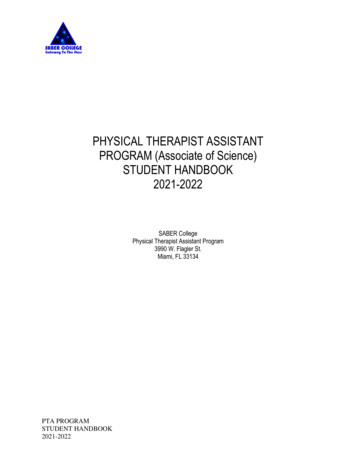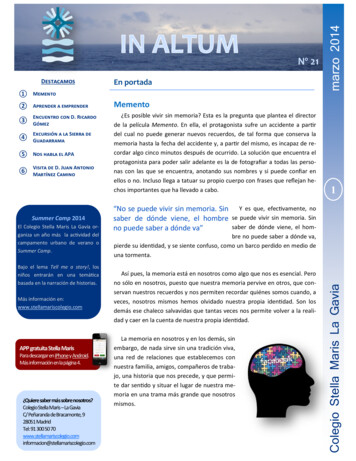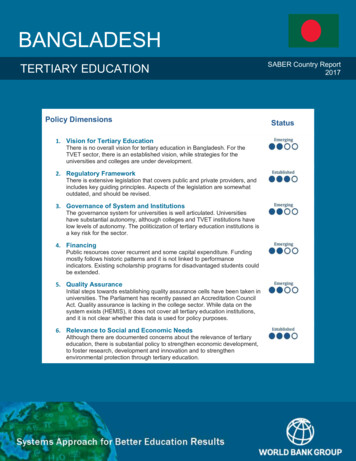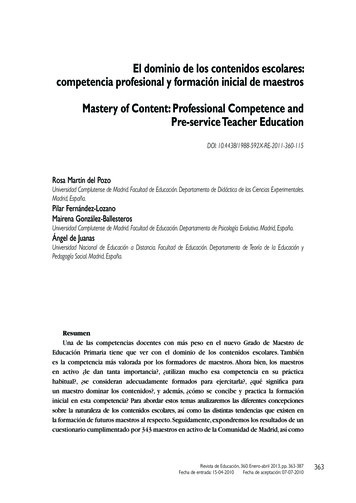
Transcription
Public Disclosure AuthorizedPublic Disclosure AuthorizedPublic Disclosure AuthorizedPublic Disclosure Authorized94451The World BankHuman Development Network – EducationSystem Assessment for Better Education ResultsSABER – SCHOOL HEALTHPreliminary Assessment of School Health Policies in theCaribbean Community (CARICOM) ȆDominica, Grenada, Guyana, Barbados, St. Lucia and St.Vincent and the Grenadines,March, 2012Summary of FindingsCountryBarbadosSt. LuciaGuyanaGrenadaDominicaSt. Vincent andthe GrenadinesHealth-relatedschool policiesSafe schoolenvironmentSchool-based rgingAdvancedLatentThis is a report on the World Bank’s System Assessment for Better Education Results(SABER) pilot initiative in the Caribbean Community (CARICOM). It is a joint effort ofthe World Bank and CARICOM and is intended to lay the groundwork for a morecomprehensive assessment of all the CARICOM countries in 2012. The report wasprepared by Roshini Ebenezer (Consultant, World Bank) and Harriet Nannynonjo (SeniorEducation Specialist, World Bank).1
2
TABLE OF CONTENTS1INTRODUCTION . 42THE IMPORTANCE OF SCHOOL HEALTH AND NUTRITION PROGRAMS . 42.1The FRESH Framework: Building Blocks for a School Health Policy Framework . 53SABER-SCHOOL HEALTH: A FRAMEWORK FOR ASSESSING SCHOOL HEALTHPOLICIES . 53.13.1.1Health-Related School Policies. 63.1.2Safe School Environment . 73.1.3School-Based Health Services . 73.1.4Health Education . 83.2456Conceptual Framework for SABER-School Health. 6Components and Scoring System of the SABER-School Health Framework . 8APPLYING SABER-SCHOOL HEALTH IN THE CARIBBEAN . 114.1School Health in the Caribbean Context . 114.2Objectives of the assessment . 124.3Methodology . 12RESULTS . 125.1Summary of Results by Country . 125.2DOMINICA . 135.3GRENADA . 155.4GUYANA. 165.5ST. LUCIA . 185.6BARBADOS . 195.7ST. VINCENT & THE GRENADINES . 215.8Comparative results by Policy Domain . 225.8.1Health-Related School Policies. 225.8.2Safe School Environment . 235.8.3School-Based Health Services . 235.8.4Health Education . 24CONCLUSION . 24
ReferencesAppendixAnnexes2
&ENCDSABERPCDCaribbean CommunityEast African CountriesEconomic Community of West African StatesCaribbean Education Sector HIV and AIDS Coordinator NetworkFocusing Resources on Effective School HealthHealth and Family Life EducationHuman development Network, Education DepartmentMonitoring and evaluationNon-Communicable DiseasesSystem Assessment for Better Education ResultsPartnership for Child Development3
1 INTRODUCTIONThis report presents the findings of the 2012 pilot assessment of the school health policies for thefollowing CARICOM countries:DominicaGrenadaGuyanaSt. LuciaBarbadosSt. Vincent and the GrenadinesThe ultimate objective of this exercise is to help countries to identify the strengths andweaknesses in their school health policy frameworks, with the understanding that sound a policyframework is a critical component of effective school health programming. The result is apreliminary report on the status of development of the school health policy framework in the sixcountries listed above. The assessment itself is part of the System Assessment for BetterEducation Results (SABER)-School Health, which was created by the World Bank as part ofits education strategy (World Bank, 2012).Section II of this report briefly discusses the importance of school health programs incontributing to education sector goals and the development of international consensus on thebasic building blocks of effective school health programs. Section III discusses the conceptualframework of SABER-School Health, and introduces the components of the SABER-SchoolHealth framework and scoring system. Section IV provides the context for and objectives of thisassessment as well the methodology used for data collection. Sections V presents the results forthe six countries: first by individual country and then as a comparative analysis across each offour policy domains. A more detailed overview of the results for each country can be found inthe Appendix.2 THE IMPORTANCE OF SCHOOL HEALTH AND NUTRITION PROGRAMSSchool health programs are now recognized as having a crucial role in improving the health,nutritional, and educational outcomes of school-aged children. For this reason, countries areincreasingly integrating these programs into their national development policies and educationsector plans. There is significant evidence that health-related factors, such as hunger and chronicillness, are underlying factors in low school enrollment, absenteeism, poor classroomperformance, and early dropping out of school (Bundy 2011). The research also shows thatschools can play a vital role in addressing these health-related factors and so improve the4
learning outcomes of school-aged children (Bundy 2011, Jukes 2008). The important role of theeducation sector in addressing poor health and malnutrition was acknowledged at the WorldEducation Forum in Dakar, Senegal, in 2000, when a multi-agency initiative between UNESCO,UNICEF, WHO, and the World Bank was launched to provide guidance on the development andimplementation of school health programs. Through this initiative, the FRESH (FocusingResources on Effective School Health) framework was developed to provide a set of unifyingprinciples to guide school health policies and programs.ʹǤͳ The FRESH Framework: Building Blocks for a School Health PolicyFrameworkThe FRESH framework suggests that the following four core components form the basis of aneffective school health program:1. Health-related school policies: including those that address HIV/AIDS and gender2. A safe and supportive school environment: including access to safe water, adequatesanitation, and a healthy psycho-social environment3. School-based health and nutrition services: including de-worming, micronutrientsupplementation, school feeding, dengue prevention, and psycho-social counseling4. Skills-based health education: including curriculum development, life-skills training, andlearning materials, including HIVThe FRESH framework also suggests that these components can only be implementedeffectively when they are supported by strategic partnerships between the health and educationsectors (Bundy, 2011). The FRESH approach promotes a shared framework that focuses onschools to promote health and learning. FRESH also seeks to involve the entire schoolcommunity, including children, teachers, parents, and other community members, while linkingschools to health services and integrating school health, hygiene, and nutrition as a strategicmeans of improving education outcomes.3 SABER-SCHOOL HEALTH: A FRAMEWORK FOR ASSESSING SCHOOLHEALTH POLICIESRecognizing school health as a key education sector sub-system, the World Bank’s HumanDevelopment Network, Education Department (HDNED) launched SABER-School Health aspart of a larger exercise aimed at reviewing all education sub-systems. The main purpose of thisinitiative is to provide standards of good practice against which countries can rate themselves(World Bank, 2012). The primary focus of SABER-School Health is to gather systematic andverifiable information about the quality of policies, rather than about their implementation, onthe premise that the foundation for effective implementation is a sound policy framework. As5
such, SABER-School Health is designed to provide a snapshot of the policy framework forschool health and lay the groundwork for a deeper analysis of its implementation at a later stage.The essence of SABER-School Health as a tool for assessment is the SABER-School Healthframework. This framework identifies the core policy domains (which serve as strategic goals)for school health programs, performance drivers that indicate progress towards realizing thesegoals, and concrete policy actions that governments can take towards establishing a strong policyframework for school health programs. Four developmental stages (latent, emerging, established,and advanced) are identified and standardized across each policy action that is introduced. Thediagnostic tools developed for SABER-School Health can be used to determine a country’sprogress in each policy area and can provide an overview of the developmental status of schoolhealth policy in the country. Ǥͳ Conceptual Framework for SABER-School HealthThe SABER framework identifies four core policy domains, aligned with the four pillars of theFRESH framework, as shown in Figure 1.Figure 1: The four pillars of the FRESH frameworkHealthrelatedschoolpoliciesSafe schoolenvironmentFRESHSchoolbased healthand nutritionservicesSkills-basedhealtheducation3.1.1 Health-Related School PoliciesEstablishing health-related school policies is a vital aspect of ensuring effective school healthprogramming. The process of setting school health policy provides an opportunity for nationalleadership to demonstrate a commitment to school health programing. School health policies also6
play a role in ensuring accountability for quality school health programming by providing a clearbasis for monitoring school health program implementation (PCD, 2012). Policies also providethe necessary guidance for a safe and gender-sensitive school environment. In many countries,girls are at a distinct disadvantage and must be mainstreamed in the education system, althoughin some countries, including much of the Caribbean, boys lag behind girls in educationalperformance. Thus, regardless of whether it is boys or girls who are lagging, such policies areintended to ensure support and structural guidance for gender mainstreaming.3.1.2 Safe School EnvironmentEnsuring a safe and supportive school environment is the second core policy goal for SABERSchool Health. A safe and supportive school environment will provide adequate water andsanitation facilities but also includes a healthy psycho-social environment. Diseases related topoor sanitation and water scarcity can lead to illnesses, to which children are often the mostvulnerable (PCD, FRESH resources 2012). Apart from the obvious health benefits of safe waterand sanitation, the absence of safe and separate sanitation facilities for girls has been shown to bea factor in preventing girls from attending school and consequently, addressing this can improvegirls’ attendance rates (PCD, FRESH resources 2011). There is also evidence that a positivepsycho-social environment at school influences the overall behavior of students. Research hasshown that factors such as “the relationships between teachers and students in classrooms,opportunities for student participation and responsibility, and support structures for teachers areconsistently associated with student progress (WHO 2003)”. Conversely, there is a strongrelationship between a negative psycho-social environment and health-compromising behaviorsamong students, such as smoking, teen sex, and alcohol misuse (WHO 2003). Ultimately, boththe physical and psycho-social school environment have been shown to impact education andsubsequently a safe and supportive school environment is a critical component in improvingeducational access and outcomes.3.1.3 School-Based Health ServicesThe third core policy goal of SABER-School Health is to ensure the delivery of school-basedhealth services. School-based health and nutrition services include screening and referral forhealth problems as well as the provision of anthelmintic treatment for parasitic infections,micronutrient supplementation, and other simple treatments that are easily administered byteachers. This critical component of school health programs has an impact on the educationalachievement of school-aged children among whom these diseases are highly prevalent (Jukes2008). Diseases such as worm infection, malnutrition, and anemia have been shown to impactnegatively on school attendance as well as on a child’s cognitive abilities, in turn affecting their7
educational performance. Also, these diseases are often preventable and treatable with simple,easily-administered treatments (Jukes 2008). School-based health and nutrition services providea cost-effective means of addressing these diseases by utilizing the existing infrastructure of theschool (including the skilled workforce of teachers and administrators), together with theresources of the health, nutrition, and sanitation sectors, to deliver substantial gains in health andeducation.3.1.4 Health EducationThe implementation of a skills-based health education is the final policy goal of SABER-SchoolHealth. The school provides a crucial platform to impact the behavior and inform the choices ofschool-aged children and adolescents. However, there is increasing evidence that effectivebehavior change among children requires more than teaching health knowledge (WHO 2012).Behavior change requires a skills-based approach to health education that focuses on thedevelopment of the knowledge, attitudes, values, and skills (including life skills, such as interpersonal skills, critical and creative thinking, decision making, and self-awareness) that areneeded to make positive health-related decisions and act on them (WHO 2012). A skills-basedhealth education is critical to improving individual behavior, alleviating social and peer pressure,addressing cultural norms, and discouraging abusive relationships: all of which contribute tohealth and wellbeing and ultimately impact the educational opportunities and outcomes ofschool-aged children. Ǥʹ Components and Scoring System of the SABER-School Health FrameworkIn addition to the core policy domains discussed above for achieving the strategic goals, there areeleven performance drivers (see Figure 2), which indicate progress. Linked to each performancedriver are a set of policy actions that a government can take to improve its school health policyframework. For each policy action, four stages of development have been identified andstandardized:a.b.c.d.Latent: very little policy implementationEmerging: policy implementation falls between latent and established levelsEstablished: minimum policy implementationAdvanced: a comprehensive policy framework implementedIdentifying the stage of each policy action helps assess the status of each policy domain andultimately the developmental status of the school health policy framework. The SABER-SchoolHealth framework used in this assessment is elaborated in Annex 1. The processes for datacollection and analysis for SABER-School Health are being developed and piloted. As such, the8
data collection tools described in Section IV as well as the scoring system presented here are in apilot stage. Figure 3 provides a sample of the scoring system for the SABER-School Healthframework.Although the FRESH framework serves as the primary guiding principle for the SABER-SchoolHealth framework, other sources have informed the concept, including the core indicators of themonitoring and evaluation (M&E) framework for school health programs developed by FRESHpartners; the experience from assessing other education sub-systems; advice from an AdvisoryCommittee of experts;1 and previous surveys of education policies in various parts of the world,including the Caribbean in 2009.2 The framework-was validated by the school healthstakeholders in 17 countries at a regional meeting of the Economic Community of West AfricanStates (ECOWAS) and in Sri Lanka.Figure 2: Core policy domains and performance drivers in school health (linked to each performance driverare a set of policy actions not shown here)1Including representatives of GlaxoSmithKline, International Food Policy Research Institute, London School ofHygiene and Tropical Medicine, Partnership for Child Development, Save the Children, UNICEF, World Bank,World Food Programme, and World Health Organization2Strengthening the Education Sector Response to School Health, Nutrition and HIV/AIDS in the Caribbean Region:A rapid survey of school health policies in 13 Countries, 20099
POLICY GOALSPOLICY LEVERSFigure 3: Sample of the scoring system for the SABER-School Health assessment10OUTCOME
4 APPLYING SABER-SCHOOL HEALTH IN THE CARIBBEANͶǤͳ School Health in the Caribbean ContextSchool-aged children in the Caribbean face the burden of diseases of both prosperity and ofpoverty, in line with most emerging middle-income countries. Caribbean governments haveidentified the major risk factors for young people in the Caribbean as: (i) early sexual initiation;(ii) high and growing rate of HIV/AIDS infection among adolescents and youth – in somecountries it is over three percent for the group aged 15 – 24 years; (iii) growing incidence ofsubstance abuse among adolescents and youth; (iv) cultural practices that endorse socialacceptance of physical and sexual abuse; (v) high incidence of crime and violence amongadolescents and youth; and (vi) increasing prevalence of non-communicable diseases (NCD)such as diabetes, hypertension, and obesity that could be reduced by the establishment of healthylife styles during childhood and youth.Early efforts to address these issues, especially the HIV/ AIDS epidemic, were largely directedthrough the health sector. Initial activities in the education sector included the development of anHIV/AIDS education curriculum and guidance/counseling programs within schools. In the 1990sthe Health and Family Life Education (HFLE) initiative was launched as a CARICOM multiagency response to HIV/AIDS and other school health challenges (O’Connell et al. 2009). In2006, in an additional response to these challenges, governments in the Caribbean committed to11
a broad health and nutrition program that specifically included HIV prevention by forming theCaribbean Education Sector HIV and AIDS Coordinator Network (EduCan). This network wasestablished to promote information sharing and to build capacity for a national education-sectorresponse to HIV/AIDS in the Caribbean. Operationally, this network has functioned as amechanism for the coordination of broader school-health interventions, especially those relatedto NCDs (Bundy 2011). In 2009, to better understand the education sector response to schoolhealth and HIV/AIDS, EduCan undertook a rapid survey of school health policy andprogramming in 13 countries in the Caribbean. The survey provided a snapshot of school healthprogramming in the region, providing one of the first cross-country comparisons of school healthpolicies that laid the groundwork for the development of standardized tools for assessing thepolicy framework for school health.ͶǤʹ Objectives of the assessmentThe ultimate objective of this assessment is to provide standards of good practice in schoolhealth for the Caribbean using the SABER-School Health framework. It would help the countriesto identify the strengths and weaknesses in their school health policy framework, and to learnfrom each other’s practices.ͶǤ MethodologyA questionnaire for school health policies was developed in line with the SABER-School Healthframework. This questionnaire is designed to be answered by focal points at the relevantministries in collaboration with other school health stakeholders in the country. Thequestionnaire was first validated in Kenya and has been piloted in 10 countries in the regionalnetwork of East African Countries (EAC). They were sent to the HFLE focal points in 12countries in the Caribbean. The HFLE coordinators were requested to complete the survey incollaboration with their counterparts in school health at the Ministry of Health and other relevantinstitutions. In cases where questions were left unanswered by the country, it was scored aslatent.5 RESULTSͷǤͳ Summary of Results by CountryBelow is a summary of the status of school health policies in Dominica (Figure 5), Grenada(Figure 6), Guyana (Figure 7), St. Lucia (Figure 8), Barbados (Figure 9), and St.Vincent and the12
Grenadines (Figure 10), which are assessed in terms of their stages of policy development aslatent, emerging, established, or advanced (Figure 4). More details of the results are given in theAppendix.Figure 4: Stages of policy developmentLatentEmergingEstablishedAdvancedͷǤʹ Figure 5: Dominica scores on policy domainsAdvancedAdvancedEstablishedLatentHealth relatedschool policiesSafe schoolenvironmentSchool basedHealth educationhealth andnutrition servicesHealth-related school policiesDominica is latent in the area of health-related school policies. There is a poverty reductionstrategy in place which includes school health, thus demonstrating some national recognition ofthe importance of school health; yet, to date, there is no national school health policy. Despitethe absence of a school health policy, a national budget line for school health programs providesfunding for “health promoting activities” through the health sector. A situation analysis has beenundertaken for the school-feeding component of the school health program and program design,and implementation has been aligned with the needs identified in this situation analysis, but thereremains a need for a broader and more comprehensive situation analysis. More attention shouldbe paid to the quality assurance of programming as there is no formal M&E plan for the schoolhealth program. Gender mainstreaming has also not been addressed in the national educationpolicy.Safe school environment13
Dominica is fairly advanced in the provision of a safe physical environment with enforcednational standards for clean water, adequate sanitation facilities, and for regulating the safety ofschool infrastructure. Mechanisms are in place to update and monitor all schools to meet thesestandards and most stakeholders have been mobilized to maintain a healthy physical schoolenvironment.There is clear room for improvement in the psycho-social dimension of the policy framework.HIV/AIDS and physical and mental disability are all identified as sources of stigmatization butthere are no systematic mechanisms in place to respond to these issues. Stigma is covered in thelife-skills curriculum and teachers receive in-service training to cover these issues, yet without astrong policy framework in place, these responses do not appear to be sufficient to addressbullying in schools due to stigma.There are national standards and guidelines on addressing institutional violence in schools butteachers do not receive in-service and pre-service training in addressing these issues. Traumaresponse in schools is addressed through psycho-social support for teachers and students who areaffected by trauma. Both teachers and students have access to this support, “child-friendly”learning spaces have been established, and school-based, psycho-social services have beendeveloped and implemented.School-based health and nutrition servicesAll the necessary components for comprehensive implementation of school-based health andnutrition services are reported to be in place. The need for school-based screening and remedialaction has also been captured in the situation analysis and outlined in national policy.Appropriate actions are being taken to address these needs and there is ongoing teacher trainingfor referral of adolescent pupils to appropriate adolescent health services.Health educationDominica appears to be advanced in the area of health education. It has a fully-developed andfully-implemented health education and participatory approach to the life-skills curriculum; preand in-service teacher training; and coverage of health-related knowledge in schoolexaminations.14
ͷǤ Figure 6: Grenada scores on policy domainsEstablishedEmergingEmergingHealth relatedschool policiesEmergingSafe schoolenvironmentSchool basedHealth educationhealth andnutrition servicesHealth-related school policiesAs in Dominica, although school health has been included in the national poverty reductionstrategy in Grenada, there is no formal school health policy in place to guide school healthprogramming in the country. However, its mechanisms for quality assurance of the programmingare advancing with an M&E system in place. A situation analysis has been conducted as part ofthis M&E plan although it is unclear how comprehensive it is. The gender dimension has beenaddressed in education policy and appears to be fairly advanced with a mechanism in place formonitoring gender mainstreaming.Safe school environmentGrenada is advanced in the provision of a safe physical environment with standards for cleanwater and adequate sanitation facilities in place. There are standards for regulating the safety ofschool infrastructure and there are mechanisms to update and monitor all schools to meet thesestandards; the community has been mobilized to maintain a healthy physical school environment.Grenada is advanced in the attention paid to the psycho-social dimension of the schoolenvironment. HIV/AIDS, physical disability, and mental disability are all identified as sources ofstigmatization and there are systematic mechanisms in place to respond to these issues. Stigma iscovered in the life-skills curriculum, teachers receive in-service training to cover these issues,and there are support groups to help students and teachers deal with these issues. However, focalpoints for school health report that the policies to address bullying due to stigma are inadequateat the school-level.There are national standards and guidelines on addressing institutional violence in schools andalso provision for psycho-social support for teachers and students who are affected by trauma;with both teachers and students having access to this support. “Child-friendly” learning spaces15
have been established and school-based psycho-social services have been developed andimplemented.School-based health and nutrition servicesThe need for school-based interventions has been identified in a situation analysis and it appearsthat some interventions have been implemented and scaled up in a targeted manner. There hasalso been an assessment of school-based screening and referral services, but these needs have notbeen outlined in national policy, and no action has been taken to implement these services.Health educationGrenada is emerging in the implementation of its national health education curriculum. Althoughit is fully developed and the material covered in its curriculum has been integrated into theschool examinations, there is no pre- or in-service teacher training to teach this curriculum, norhave teaching materials been developed for it and thus the quality of this coverage is unclear.There are participatory approaches in place to teach age-appropriate and sex-specific life-skillsfor health behaviors and these have also been integrated into the national curriculum, but, onceagain, there is no teacher preparation to teach this curriculum.ͷǤͶ Figure 7: Guyana scores on policy domainsEmergingEmergingEmergingSchool basedhealth andnutritionservicesHealtheducationLatentHealth relatedschool policiesSafe schoolenvironmentHealth-related school policiesGuyana is latent in the area the implementation of health related school policies although it hasan emerging national school health policy, published by the education sector. Most stakeholdershave a copy of this policy and are being trained on its implementation. The other components ofeffective school health policy are latent. An incomplete situatio
The essence of SABER-School Health as a tool for assessment is the SABER-School Health framework. This framework identifies the core policy domains (which serve as strategic goals) for school health programs, performance drivers that indicate progress towards realizing these










